Abstract
In order to investigate the effect of a synthetic jet arranged at the suction surface on the aerodynamic performance of an axial flow compressor, a high-speed subsonic axial flow compressor rotor was numerically simulated in this paper. The results showed that after being excited by the synthetic jet, the flow margin of the compressor decreased by 1.3%, but the peak efficiency increased by 0.47%. After analyzing the internal flow field, it was found that although the alternating blowing and suction effect of the synthetic jet can reduce the separation loss of the suction surface, the radial velocity of the flow is higher when stimulated and converges towards the blade tip, resulting in more severe blockage at the blade tip than in the prototype compressor, leading to a slight decrease in stability margin. To balance the stability margin of the compressor, a coupled flow control numerical simulation combining passive control of the casing treatment and active control of the suction surface synthetic jet was subsequently carried out. The results showed that the coupled flow control could exert their respective advantages, resulting in an increase of 17.84% in the compressor flow margin and a decrease of only 0.2% in peak efficiency.
1. Introduction
Axial flow compressors are one of the three core components of aviation engines. Due to the extremely important role of the status, extremely demanding working environment, and extremely strict performance and safety requirements, flow control for axial flow compressors, expanding their stable working range, and improving their aerodynamic performance have always been one of the hot research topics in this field. Common flow control strategies include boundary layer suction [1,2], plasma excitation [3,4], casing treatment [5,6,7], or air injection [8,9,10]. These methods either require complex external piping systems or significantly reduce the efficiency of the compressor. Compared to the aforementioned measures, the active flow control method based on a synthetic jet has more obvious advantages, such as fast response, good performance, no need for complex pipelines, and low energy consumption. It is an extremely promising flow control technology that is worthy of in-depth research [11,12]. Previous research on compressor cascades has shown that under reasonable parameters such as jet frequency and peak velocity, the synthetic jet has the effect of reducing flow separation and total pressure loss [13]. However, from the existing research, the main research objects of synthetic jets in compressors are cascades. Compared with the compressor cascade, the internal flow of the axial flow compressor is more complicated due to rotor blade torsion and high-speed rotation. Whether this active flow control technology is still effective deserves further investigation. Surprisingly, although there is still limited research on synthetic jets for axial compressors, they have attracted people’s attention. For example, the literature [14,15] conducted numerical research on the suction surface synthetic jet using NASA Rotor 37 as the research object, but these papers only discussed two operating conditions: design point and near-stall point. As one of the important indicators of compressors, it is still unknown whether the stability margin changes after being stimulated by a synthetic jet. Therefore, the influence of synthetic jet active flow control on the stability margin of the axial flow compressor is obtained by simulation in the whole working condition range, which is one of the bases of this paper.
In addition, the author of this paper has conducted numerical simulation research on a transonic and a subsonic axial flow compressor by arranging synthetic jets on the casing over the full operating range, respectively, and obtained the influence laws of multiple parameters [16,17]. The results indicate that active flow control based on synthetic jets at the casing position can reduce flow loss, expand the stability margin, and improve the aerodynamic performance of the compressor. However, in the internal flow of a compressor, in addition to the losses caused by blade tip leakage flow, other losses also play an important role. It is still unknown whether flow control at other locations, such as blade surface, can also have a positive effect on compressor performance. This is the second research foundation of this paper. In fact, flow control on the blade surface can directly target the flow in the compressor channel, which may be more effective in reducing flow losses.
For civil aviation aircraft, the widely used imported stage axial fans or compressors nowadays are generally high-speed subsonic axial compressors. Therefore, based on the above analysis, previous research, and the author’s existing results, this paper continues to conduct numerical research on a high-speed subsonic axial compressor rotor. The influence of a synthetic jet on the performance and stability margin of the compressor was explored by arranging it on the suction surface of a rotor blade.
2. Research Object and Numerical Simulation Method
2.1. Research Subjects
The research object of this paper is the isolated rotor of the high-speed subsonic axial compressor experimental platform in the Axial Flow Compressor Laboratory of Northwestern Polytechnical University, as presented in Figure 1. The compressor is driven by an electric motor with radial intake and axial exhaust. The compressor state is controlled and throttled by adjusting the position of the outlet tail cone. The basic design parameters and performance indicators are as follows: design speed 15,200 r/min, flow rate 5.6 kg/s, total pressure ratio 1.249, and adiabatic efficiency 0.905. The diameter of the rotor hub is 0.09 m, and the diameter of the casing is 0.149 m. The number of rotor blades is 30, the top chord length of the rotor blades is 0.03 m, the aspect ratio is 1.925, the top installation angle of the blades is 37°10′, the root installation angle of the blades is 59°50′, and the top clearance of the rotor blades is 0.3 mm.
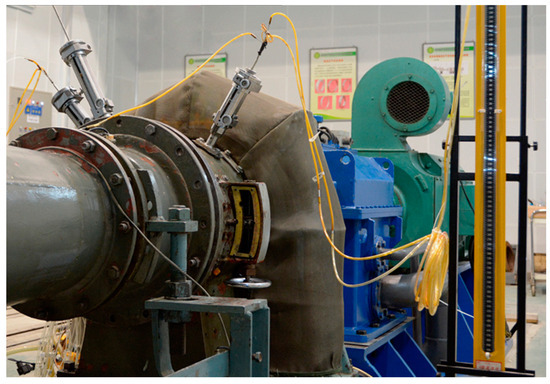
Figure 1.
Compressor test bench.
2.2. Numerical Simulation Methods and Effectiveness
Establish a single-channel computational domain from the radial inlet to approximately 5.7 times the chord length downstream of the rotor outlet, as presented in Figure 2. Use the IGG/AutoGrid5 module of NUMECA 16.1 software to divide grids. The entire computational domain grid is divided into two parts along the flow direction: the stationary region from the radial inlet to the leading edge of the rotor inlet, and the remaining region is the rotational region. The height of the first layer of the grid is set to 5 × 10−6 m, and the blade channel adopts an O4H-type grid topology. A total of 205 grid nodes are arranged around the blade, and 93 grid nodes are arranged along the blade’s height. The blade tip gap adopts a butterfly grid topology, with 17 grid nodes arranged radially in the gap, and the remaining areas adopt an H-shaped grid topology. The entire computational domain grid is approximately 960,000, as presented in Figure 3.
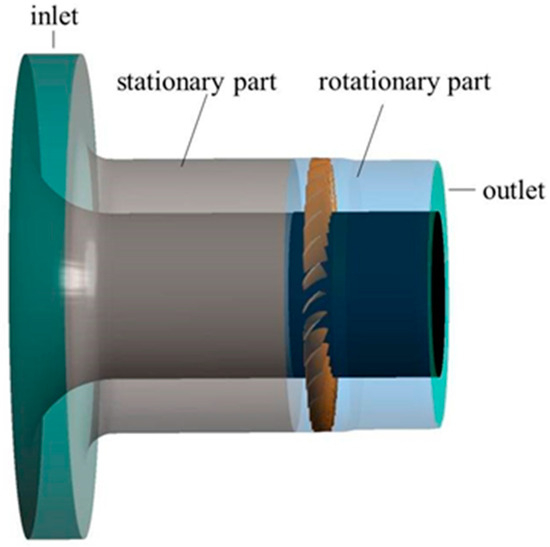
Figure 2.
Computational domain.
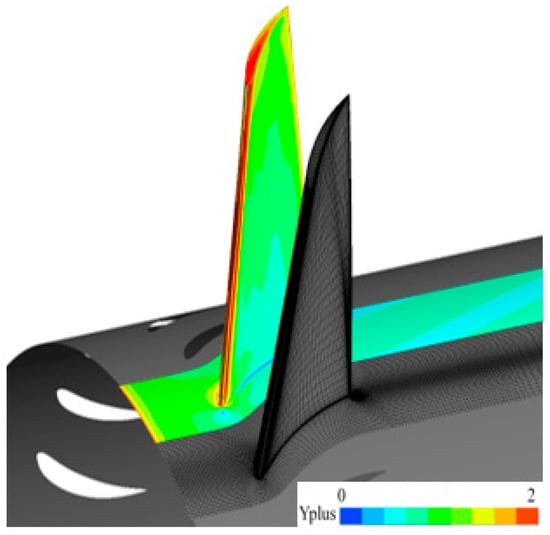
Figure 3.
Mesh and y+ contour.
Using ANSYS CFX 18 software for single-channel calculation, the speed of the prototype compressor was set to 8130 r/min and 10,765 r/min, respectively, to compare with experimental results and verify the reliability of the numerical model. During the calculation process, the working fluid is set as an ideal gas, and the k-omega turbulence model is used to solve the three-dimensional Reynolds time-averaged N-S equation in a relative coordinate system. The spatial term is discretized using a second-order upwind difference scheme, while the temporal term is discretized using the fourth-order Runge–Kutta method. The mixed plane method is used for data transfer at the rotational and static interfaces. The inlet of the compressor is set to the total temperature and total pressure of the standard atmosphere, and the outlet is set to the average static pressure. Starting from low back pressure, gradually increase the back pressure until numerical convergence is not possible. At this point, it is also considered that the compressor is physically stalled, and the performance of the compressor with the last convergent back pressure before divergence is considered near-stall performance.
Figure 4 presents a comparison of the total performance of the subsonic axial compressor rotor obtained from experimental measurements and numerical calculations. From the graph, it can be concluded that the near-stall flow rate, total pressure ratio, and efficiency obtained from numerical calculations are in good agreement with experimental measurements, but there are also certain errors, which may be related to factors such as ideal gas assumption and turbulence model selection during software settings. However, the overall trend of the parameters obtained from numerical prediction and experimental measurement is consistent, and the distribution of the total pressure ratio at the outlet of the three operating conditions of 8130 r/min presented in Figure 5 is also consistent with the experimental measurement results. Therefore, it can be considered that the numerical model established in this paper is reliable, and further research will be conducted on this basis.
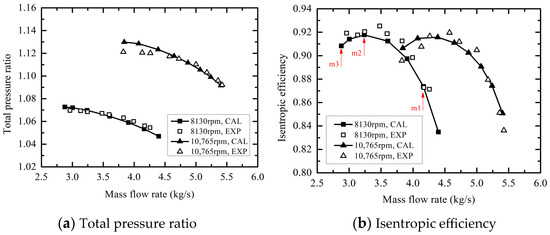
Figure 4.
Total performance of compressor.
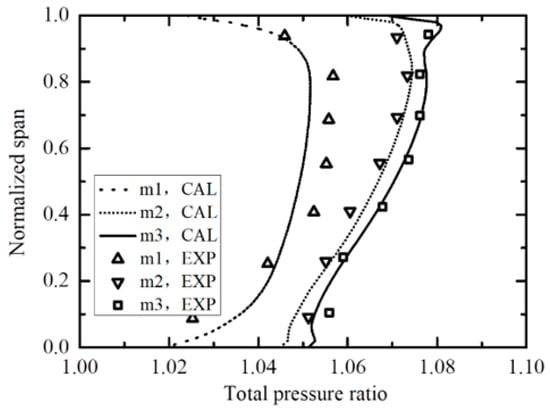
Figure 5.
Distribution of total pressure ratio.
3. Analysis of Internal Loss Changes in Compressor
Dissipation function is the only term in the flow equation that can convert mechanical energy into thermal energy. Strong velocity shear produces high fluid dissipation. Therefore, the dissipation function can reflect the local flow characteristics. Compared to the method of using total pressure to represent losses, the dissipation function is more conducive to observing the mechanism of loss generation.
represents the dissipation function, whose tensor form is defined as follows:
In the equation, u represents velocity and represents the comprehensive viscosity coefficient.
Using this method, the internal flow loss of the compressor is first divided into regions according to the source, and then the dissipation function of each region is integrated in a three-dimensional form to obtain the size of the loss in that region. Finally, the dimensionless loss source is obtained by dividing it by the inlet dynamic pressure [18].
In the equation, is the loss source, representing the total pressure loss in a specific area, in is the inlet measurement cross-section, and Vn and A are the normal velocity and area of the integration surface, respectively.
For the subsonic axial compressor rotor, as presented in Figure 6, the integration region of the total pressure loss source and corresponding dissipation function is divided into five parts:

Figure 6.
Division of loss sources in compressor rotor.
① Inlet losses . The axial range is from the inlet measurement section to the leading edge of the blade tip, and the radial range is between 2% Span and the gearbox.
② Hub loss . The axial range is from the inlet measurement section to the outlet measurement section, and the radial range is between the hub and the 2% Span. It is worth noting that the 2% Span is not the thickness of the boundary layer but rather an approximate representation of the scale of near-wall shear flow caused by hub friction.
③ Tip leakage and separation loss . The axial range is from the leading edge of the blade tip to the trailing edge of the blade tip, and the radial range is between 85% Span and the gearbox.
④ Outlet loss . The axial range is from the trailing edge of the blade tip to the measured cross-section of the outlet, and the radial range is between 2% Span and the gearbox.
⑤ Passage loss . Other areas. According to the numerical results, the leakage loss at the blade tip is mainly located above about 90% Span. Therefore, this paper sets the radial boundary between the leakage loss at the blade tip and the channel loss at 85%.
Figure 7 presents the proportion of each loss to the total loss under three working conditions. As depicted in the picture, the proportion of inlet loss, hub loss, and outlet loss in the total loss changes slightly, while the passage loss, tip leakage, and separation loss change significantly. With the throttling of the compressor rotor, the proportion of passage loss decreases gradually while the proportion of tip leakage and separation loss increases significantly, reaching more than 40%. Therefore, the loss of the compressor rotor is mainly in the tip and passage, and the tip leakage and separation loss are the main sources of the loss, followed by the passage loss. If the flow control measures are taken at the blade tip and passage, the loss of the compressor rotor may be reduced, and its aerodynamic performance may be improved, which is the main basis of this paper.
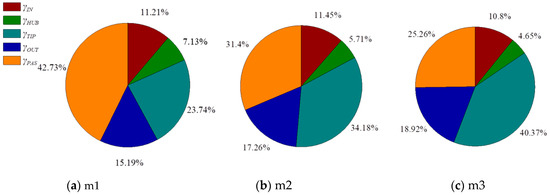
Figure 7.
Proportion of loss sources in compressor rotor.
4. Synthetic Jet Design
To investigate the synthetic jet on the suction surface of rotor blade, it is necessary to determine the excitation position. What can be learned from the existing research is that when the boundary layer of the suction surface of the compressor rotor blade is pumped, the suction position is usually arranged in the separation zone rather than in front of the separation zone. This is because the main purpose of boundary layer suction is to extract the low-energy fluid on the blade surface to weaken the separation of the suction surface. If the suction position is arranged in front of the separation area, it is bound to suck the non-separated flow early but cannot inhibit the separated gas flow. However, it should be noted that the suction position should not be arranged too far back in the separation area. At this time, the flow has been greatly separated, and suction at the too-far back position will affect the suction mass flow and effect. Therefore, when performing boundary layer suction, the suction position is usually arranged in the first half of the separation zone. Using the method of boundary layer suction for reference, the excitation position is also arranged in the separation zone when the synthetic jet on the suction surface of the rotor blade is investigated.
In fact, because the total pressure ratio of this subsonic compressor rotor is low, the separation line of the suction surface is close to the trailing edge of the blade, and the thickness of the trailing edge blade is limited, it is not suitable to set multiple synthetic jet excitation slots to investigate the optimal axial position of the excitation. Therefore, this paper only designs and calculates one excitation position. As depicted in Figure 8, the axial position of synthetic jet excitation is 88% Ca from the leading edge (Ca refers to the axial chord length of the blade tip). To prevent the interference of clearance flow, 1 mm is reserved from the synthetic jet to the blade tip. In the numerical simulation, the outlet velocity model is adopted. The grid on one side of the suction surface of the rotor blade is locally densified, and 0.3 mm wide is cut out as the velocity outlet of the synthetic jet. The boundary condition of the velocity inlet is directly given at the outlet, and the angle between the jet direction and the tangent direction of the suction surface is about 30°.
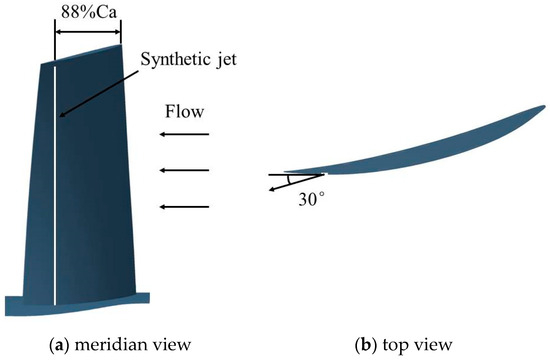
Figure 8.
Schematic diagram of synthetic jet on the suction surface of subsonic axial compressor rotor.
The velocity of the synthetic jet is defined as follows:
In the above equation, the initial phase is set to 0. The selection of other parameters is based on reference [14], which also conducted numerical simulation research on the synthetic jet on the suction surface of an axial compressor rotor. The excitation frequency in the paper is 600 Hz, and the jet peak velocities are 200 m/s and 300 m/s, respectively. For the setting of jet peak velocity, the paper points out that the actual synthetic jet actuator can reach a value of 80–120 m/s, but the value used in reference [14] far exceeds the maximum value generated by the actual synthetic jet actuator. However, the author further emphasizes that their purpose is not to provide strict real-world figures but to demonstrate how high the jet velocity should be to have an undeniable impact on transonic blades. As the research object of this paper is a subsonic compressor, the jet peak velocity can be further reduced. Therefore, referring to the parameter settings in reference [14], this paper sets the excitation frequency and jet peak velocity as f = 600 Hz, Vmax = 50 m/s. The velocity distribution of a sinusoidal form of synthetic jet in a period is depicted in Figure 9. Eight typical moments are also highlighted.
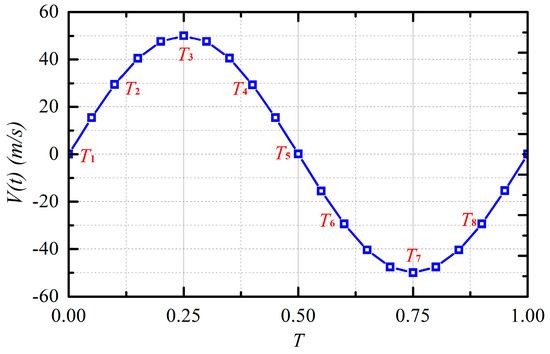
Figure 9.
Synthetic jet velocity curves at different times.
In the unsteady calculation of simulating synthetic jet excitation, the time term adopts the second-order backward Euler scheme, the physical time step is 1/20 of a synthetic jet cycle, and each physical time step has 10 virtual time steps.
5. Influence and Analysis of Synthetic Jet on Compressor Performance
5.1. Effect of Synthetic Jet on Overall Performance of Compressor
Define the flow stability margin improvement:
where m is the mass flow rate, the subscripts SW and SJ represent the prototype and the compressor excited by the synthetic jet, respectively, and the subscript NS represents the near-stall condition.
Since the synthetic jet excitation has input energy to the compressor, the influence of this energy should be considered when calculating the efficiency of the compressor. The method proposed by Bae is used to calculate the power required when the synthetic jet is injected into the compressor [19]:
where E is the power, ρ is the density, and A is the inlet area of the synthetic jet. Therefore, the calculation formula of the compressor efficiency considering the energy input of the synthetic jet is as follows:
where and are the total pressure and total temperature, respectively, the subscripts a and b represent the compressor’s inlet and outlet measurement sections, and is the adiabatic index.
The amount of change in efficiency is defined as follows:
Figure 10 presents the effect of synthetic jet on the suction surface on the overall performance of the compressor rotor. It can be seen that the total performance of the compressor decreases slightly under high flow conditions, but the amplitude is very small. From before the maximum efficiency point, the total pressure ratio and efficiency of the compressor began to increase, and the total pressure ratio and efficiency at the peak efficiency point increased by 0.04% and 0.47%, respectively. It is worth noting that the near-stall flow of the compressor excited by the synthetic jet increased by 0.03755 kg/s, so the flow margin decreased by 1.3%. When studying the synthetic jet on the suction surface of the NASA Rotor37 blade, the literature [14,15] only calculated the design point and the near-stall point and did not get the performance change of the compressor in the whole operating range after the synthetic jet on the suction surface was excited. Therefore, the change in the stability margin of the compressor was not obtained, and looking at the existing literature, this paper is the first to carry out this research. Since the flow rates of the two near-stall points are not significantly different, the flow rates of the two near-stall points are directly considered to be approximately equal in this paper. Compared with the prototype compressor, the total pressure ratio and efficiency of the compressor near-stall point increased by 0.08% and 0.79%, respectively.

Figure 10.
Effect of synthetic jet on the total performance of subsonic axial compressor.
5.2. Internal Flow Analysis of Compressor
To reveal the influence mechanism of the suction surface jet on the overall performance and stability margin of the compressor, take the near-stall mass flow of the prototype compressor. As an example, Figure 11 presents the relative Mach number contour at different spans. The relative Mach number contour of 95% Span presents that after the suction surface synthetic jet excitation, the tip blockage is similar to that of the prototype compressor, so the root cause of compressor stall does not change after the suction surface synthetic jet excitation. At the same time, it can also be obtained that near 5% Span at the root and 95% Span, the synthetic jet of the suction surface has almost no effect on the separation of the suction surface. However, at the height of the middle range between 30% Span and 70% Span, after the excitation of the synthetic jet, the separation degree of the suction surface is slightly smaller than that of the prototype compressor in the first half stage of blowing and the second half stage of inhaling. Although this change cannot expand the stability margin of the compressor, it is beneficial to reduce the separation loss of the trailing edge of the rotor suction surface and then improve the compressor’s diffusing work capacity and aerodynamic efficiency. The reason for the analysis is that during the suction stage of the synthetic jet, due to the fact that the suction direction of the synthetic jet is the same as the separation flow direction on the suction surface, the synthetic jet can suck some of the separated flow into the groove, reducing separation losses. However, due to the hysteresis of the excitation of the synthetic jet, it may still be able to reduce the blowing speed until it reaches its maximum. In the blowing stage, the blowing speed direction of the synthetic jet is opposite to the direction of the separated flow on the suction surface, which will further increase the degree of separation and separation loss on the suction surface. This indicates that for the subsonic axial compressor rotor, the suction effect of the synthesized jet at the suction surface position is more effective in reducing flow losses than the blowing effect.
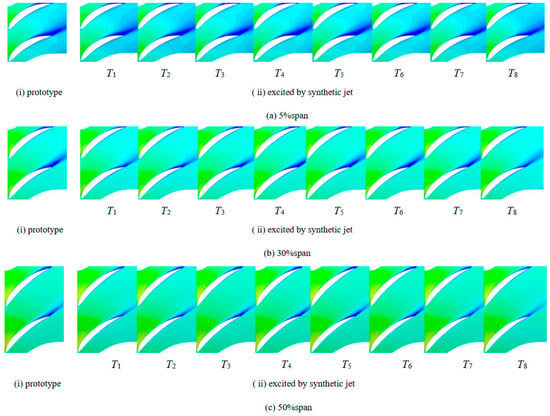
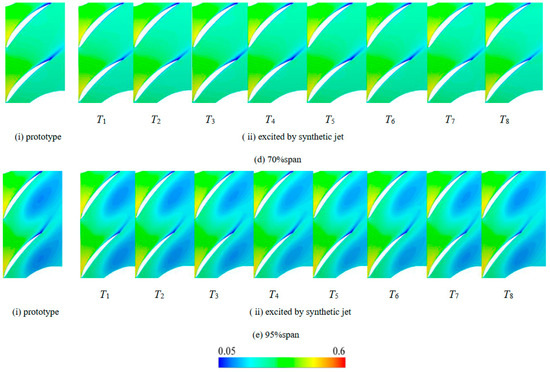
Figure 11.
Relative Mach number contour at different spans.
Figure 12 presents the radial velocity contour of the suction surface of the prototype compressor and the compressor excited by the synthetic jet. Just as the effect of synthetic jet on the separation degree of the trailing edge of the suction surface at different spans, when the synthetic jet is in the suction stage, starting from time T5, as the suction speed of the synthetic jet gradually increases, the separation of the trailing edge of the suction surface in the middle of the blade decreases, reducing the degree of blockage at this position. Therefore, the radial velocity of the flow at this position is higher than that of the prototype compressor, leading to faster convergence of the flow towards the blade tip. The effect of the synthetic jet continues until the T2 moment of the next synthetic jet cycle. In the blowing stage of the synthetic jet (T3–T4), the blowing effect actually increases the separation of the suction surface, which creates greater obstacles to the radial movement of the flow, resulting in a slight decrease in radial velocity. Based on the radial velocity analysis of a synthetic jet cycle, after being excited by the suction surface synthetic jet, more air in the compressor channel flows towards the blade tip, resulting in more severe blockage of the blade tip channel than the prototype compressor. Therefore, the stability margin of the compressor rotor has slightly decreased. Based on the analysis of Figure 11 and Figure 12, although the suction effect of the synthetic jet is more advantageous than the blowing effect in reducing losses, it should also be noted that it also causes a slight decrease in the stability margin of the compressor.

Figure 12.
Contour of radial velocity.
Figure 13 presents the limiting streamlines of the suction surface of the prototype compressor and the compressor excited by the synthetic jet. At T1, due to the influence of the suction effect of the previous synthetic jet cycle, at this time, the separation line at the trailing edge of the suction surface almost coincides with the jet slit, and a second separation line appears near the trailing edge of the blade after the separation line, and a separation bubble is formed between the two separation lines. With the increase in blowing velocity, the blowing effect of the synthetic jet will blow the flow behind the jet slit downstream, the separation bubble and the second separation line disappear, and the first separation line also moves upstream of the jet slit. The forward movement of the separation line indicates that the separation degree of the trailing edge of the suction surface increases, resulting in a corresponding increase in separation loss. From the figure, it can also be seen that as the blowing speed of the synthetic jet increases, it actually hinders the upward movement of the radial flow and alleviates the blockage at the blade tip. But soon after T5, the blowing velocity drops to 0, and the synthetic jet is about to enter the suction phase. With the increase in the suction velocity, the synthetic jet will suck the low-speed flow behind the separation line into the slit, making the original separation line of the suction surface gradually move towards the trailing edge of the blade. When it moves back to the slit, it will stop moving back and stabilize at this position, so the suction surface will move back. It indicates that the separation of the trailing edge of the suction surface is reduced, and the separation loss of the compressor is also reduced. In the suction stage, due to the absorption of the separated flow at the trailing edge of the suction surface by the synthetic jet, the radial flow accelerates the convergence towards the blade tip, resulting in a decrease in compressor margin. At the same time, downstream of the jet slit, due to the synthetic jet not completely absorbing the flow before the slit, there is still a very small portion of the flow that crosses the jet slit and moves downstream. This portion of the flow separates from the original suction surface trailing edge and converges at the downstream position of the jet slit, gradually forming a second separation line at that position. Therefore, separation bubbles appear between the two separation lines. Due to the hysteresis of the compressor response after the synthetic jet excitation, as the suction speed increases, the second separation line continues to move downstream, and the axial range of the separation bubble expands. This process continues until the suction speed reaches its maximum T7 moment and is still reflected at the T1 moment when the blowing begins in the next synthetic jet cycle.

Figure 13.
Distribution of limit streamlines on suction surface.
Figure 14 presents the variation of the relative total pressure loss coefficient of the measured section at the compressor outlet during a synthetic jet cycle. The total pressure loss coefficient of the compressor presents a standard sinusoidal law, but its phase lags the inlet velocity of the synthetic jet by about 1/8 T. At the same time, at the beginning of the synthetic jet blowing stage and the whole suction stage, the total pressure loss coefficient is lower than that of the prototype compressor, and the maximum loss coefficient is reduced by 45.85%, with an average reduction of 8.61%, which indicates that for the synthetic jet excitation on the suction surface, the suction effect is more favorable than the blowing effect for reducing the compressor loss.
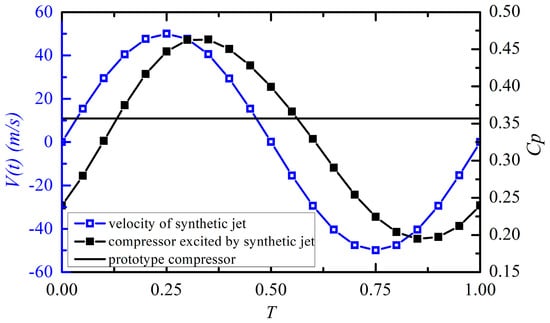
Figure 14.
Changes of total pressure loss coefficient.
In order to more carefully observe and compare the changes in compressor losses before and after the synthetic jet excitation on the suction surface, the loss source is used to quantify the description method. As presented in Figure 15, the inlet loss and hub loss have little change. The maximum tip leakage loss decreases by 12.7%, and the average decreases by 8.27%, and the maximum channel loss decreases by 9.33%, and the average decreases by 4.75%. It is worth noting that the outlet loss decreases most significantly, with a maximum reduction of 28.7% and an average reduction of 18%, which is mainly due to the weakening of the separation degree of the suction surface of the compressor and the more uniform outlet flow after the synthetic jet excitation of the suction surface.
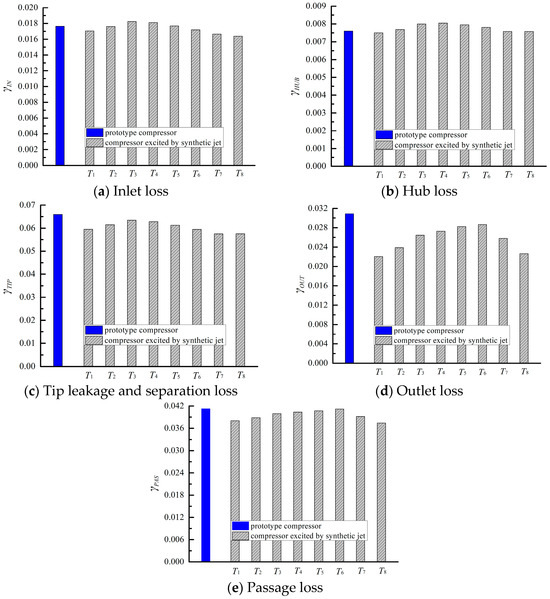
Figure 15.
Changes of loss sources.
6. Influence and Analysis of Coupled Flow Control on Compressor Performance
6.1. Slotted Casing Treatment Design
The above analysis points out that for the subsonic axial compressor rotor, the synthetic jet on the suction surface of the rotor blade can improve its aerodynamic performance but cannot expand its stable working range. To give full play to their respective advantages, this paper combines the active control of the synthetic jet on the suction surface with the passive control of slot casing treatment to achieve the purpose of expanding the stable working range of the compressor without reducing or reducing the efficiency of the low-pressure compressor. As the stall of the compressor is caused by the blockage of the front half of the blade top channel, considering the minimization of efficiency loss, when designing the slotted casing treatment structure, an inclined short slot with an axial length of 7 mm covering only 50% of the axial chord length in front of the blade top was improved and explored. Each rotor channel has eight slots, with a circumferential coverage ratio of 50% and an inclination of 45° to the rotor rotation direction, as depicted in Table 1, Figure 16 and Figure 17. The total number of grids for the eight seams is about 845,000. In the steady calculation, the slot and the solid wall casing are connected by the frozen rotor method, and in the unsteady calculation, the transient rotor static method is used.

Table 1.
Structural parameters of slot casing treatment.

Figure 16.
Structure of slot casing treatment.
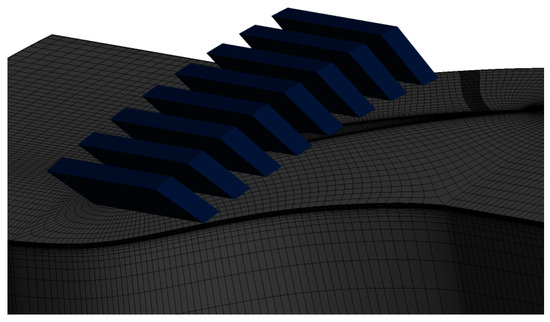
Figure 17.
Grid of slot casing treatment.
6.2. Effect of Coupled Flow Control on Overall Performance of Compressor
Figure 18 presents the overall performance of the compressor rotor before and after coupled flow control. The stable working range of the compressor is significantly expanded, and the flow margin is increased by 15.67% when the slot casing treatment is used alone. At the flow point of the prototype compressor under near-stall conditions, the total pressure ratio is increased by about 0.13%, but the efficiency is reduced by about 0.46%. At the peak efficiency point, the total pressure ratio is almost unchanged, but the efficiency is reduced by about 0.93%. During the coupled flow control, the stable working range of the compressor was further expanded, but the range was very small, and the flow margin was expanded by 17.84%. At the flow point of the prototype compressor under near-stall conditions, the total pressure ratio was increased by about 0.21%, and the efficiency was increased by about 0.28%. At the peak efficiency point, the total pressure ratio was slightly increased, but the range was very small, and the efficiency was only reduced by about 0.2%.
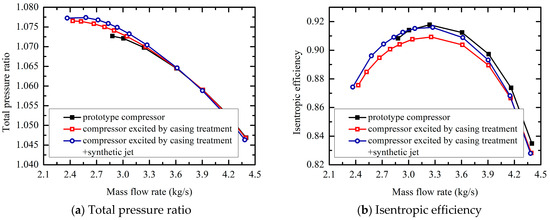
Figure 18.
Effect of coupled control on the total performance of compressor.
6.3. Mechanism of Coupled Flow Control to Improve Compressor Performance
Figure 19 presents the internal flow situation of the compressor under different flow control methods. It is clear to compare the differences between the tip leakage flow, the radial velocity of flow at the channel outlet, and the radial velocity at the bottom of the slot in three different scenarios. During the prototype compressor, due to the high back pressure, the tip leakage flow could not pass out smoothly at the top of the blade, resulting in extensive blockage. After the casing treatment, due to the pressure difference between the suction surface and the pressure surface at the blade top, when the casing treatment passes through the blade top, under the action of the pressure difference, the low-speed flow at the pressure surface blade top is sucked into the slot casing treatment and then sprayed out on one side of the suction surface. This effectively decreased the blade top load, reduced the angle between the leakage flow at the blade top and the suction surface, and significantly increased the speed of tip leakage flow. Therefore, the stability margin of the compressor with casing treatment is significantly increased. When coupled with flow control, the casing treatment still effectively plays a stabilizing role. From the radial velocity distribution of the flow on the outlet surface of the blade channel, the radial velocity (time-averaged value) after the action of the synthetic jet is greater than that of the prototype compressor, which is consistent with the influence of the synthetic jet on the separation and separation loss of the suction surface mentioned earlier. The driving effect of the synthetic jet on radial flow will reduce the degree of separation at the trailing edge of the suction surface, effectively reduce separation losses, and improve the aerodynamic efficiency of the compressor.
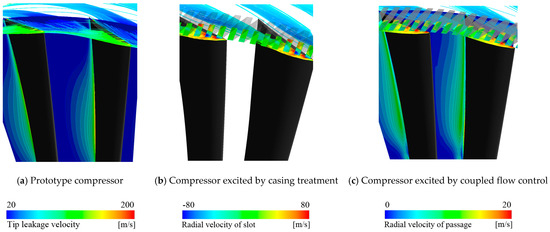
Figure 19.
Comparison of internal flow in compressors under different flow control methods.
Figure 20 and Figure 21, respectively, present the changes in total loss and internal loss sources of the compressor. From the change in the total loss, the compressor loss is reduced after the casing treatment, but from the overall performance chart, the introduction of the slot leads to a decrease in the compressor efficiency, which indicates that the power capacity of the compressor is reduced due to the introduction of the casing treatment. After the coupled flow control, the loss of the compressor is further reduced due to the excitation of the synthetic jet. Therefore, the compressor efficiency is improved compared with the prototype and the simple casing treatment. From the change in each loss source, the import loss and hub loss have little change. The channel loss is slightly reduced, indicating that the flow in the compressor channel is more uniform than that in the prototype compressor. The tip leakage loss is reduced most significantly, which corresponds to the suppression of tip leakage flow and the great improvement of tip flow after the above-mentioned slot casing treatment. The casing treatment loss is reduced, and the outlet loss is also significantly reduced. This is because after the slot casing treatment, the wake loss of the tip leakage flow is reduced, and the outlet flow is more uniform. Especially after the coupled flow control, the suction surface separation is also restrained to a certain extent, the outlet flow is more uniform than the pure slot casing treatment, and the outlet loss is further reduced.
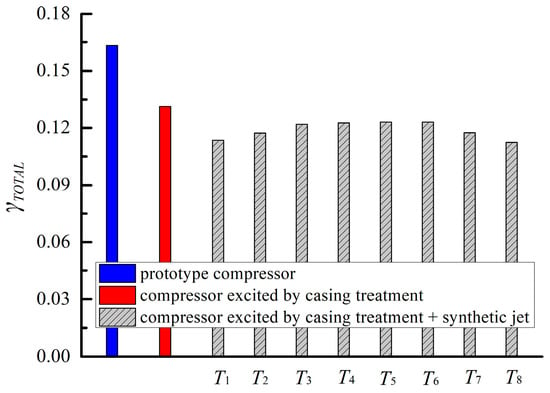
Figure 20.
Changes of total loss.
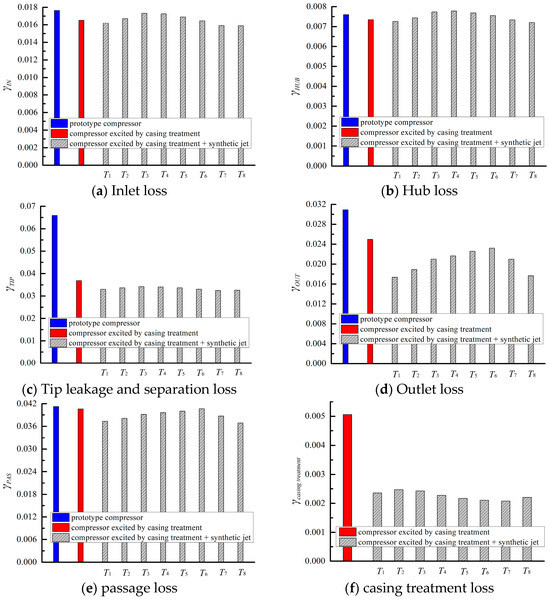
Figure 21.
Changes of loss sources.
7. Conclusions
- (1)
- The total pressure ratio and efficiency of the compressor can be improved by the synthetic jet excitation of the suction surface with reasonable parameters in the range of operating conditions other than the high flow operating point. Compared with the prototype compressor, the peak efficiency of the compressor increased by 0.47% after introducing synthetic jet excitation, and the efficiency near the stall point increased by 0.79%. For the compressor whose instability is triggered by the tip blockage, the synthetic jet of suction surface cannot improve its stability margin due to the limitation of the action position; it will even slightly increase its near-stall flow.
- (2)
- After being excited by the synthetic jet on the suction surface, the stability margin of the compressor slightly decreases. This is because the synthetic jet absorbs the separated flow on the suction surface during the suction stage. Although it can reduce the degree of separation on the suction surface, it also causes the radial velocity of the flow in the compressor channel to be higher and more concentrated towards the blade tip, resulting in more severe blade tip blockage than the prototype compressor and a slight decrease in stability margin.
- (3)
- The reason for the efficiency improvement of the compressor after being excited by the synthetic jet on the suction surface is that the suction effect of the synthetic jet significantly reduces the leakage and separation losses at the blade tip, channel losses, and outlet losses. For the subsonic axial flow compressor, the suction effect of the synthetic jet is more favorable for reducing losses than the blowing effect.
- (4)
- After the coupled flow control, the stability margin of the compressor can be expanded, which is the contribution of the slot casing treatment. It can suck low-speed flow at the top of the blade and spray from the front section, which alleviates the blockage at the blade top and greatly improves the flow condition at the blade top. The improvement of the compressor efficiency is mainly due to the contribution of the synthetic jet on the suction surface, which reduces the separation loss by suppressing the separated flow on the suction surface at the midspan of the blade.
Author Contributions
Conceptualization, G.W. and Q.W.; methodology, G.W.; software, W.C.; validation, G.W., Q.W. and Y.L.; formal analysis, G.W.; investigation, G.W.; resources, G.W.; data curation, W.C.; writ-ing—original draft preparation, G.W.; writing—review and editing, G.W.; visualization, G.W.; su-pervision, W.C.; project administration, G.W.; funding acquisition, G.W. All authors have read and agreed to the published version of the manuscript.
Funding
This research was funded by the National Natural Science Foundation of China (No. 52366002).
Institutional Review Board Statement
Not applicable.
Informed Consent Statement
Not applicable.
Data Availability Statement
The original contributions presented in the study are included in the article, further inquiries can be directed to the corresponding author.
Conflicts of Interest
The authors declare no conflicts of interest.
References
- Zhang, P.; Liu, B.; Dong, W.L. Research on endwall boundary layer suction in a counter-rotating compressor. J. Aeronaut. Astronaut. Aviat. 2022, 54, 109–120. [Google Scholar]
- Chen, S.W.; Gong, Y.; Zeng, C. Pulsed suction towards unsteady active flow control in an axial compressor cascade including clearance leakage effects. Appl. Therm. Eng. 2023, 219, 119654. [Google Scholar] [CrossRef]
- Shen, J.M.; Wu, Y.; Zhang, H.D.; Wang, Y.Z.; Tang, M.X. Flow control effect of spanwise distributed pulsed arc discharge plasma actuation on supersonic compressor cascade flow. J. Therm. Sci. 2022, 31, 1723–1733. [Google Scholar] [CrossRef]
- De Giorgi, M.G.; Motta, V.; Suma, A.; Laforì, A. Comparison of different plasma actuation strategies for aeroelastic control on a linear compressor cascade. Aerosp. Sci. Technol. 2021, 117, 106902. [Google Scholar] [CrossRef]
- Vuong, T.D.; Kim, K.Y.; Dinh, C.T. Recirculation-groove coupled casing treatment for a transonic axial compressor. Aerosp. Sci. Technol. 2021, 111, 106556. [Google Scholar] [CrossRef]
- Maher, N.H.; Ross, M.H.; Morris, S.C.; Priebe, S.; Jothiprasad, G.; Allan, D.; McNulty, G.; Macrorie, M.; Mallina, R. Experimental and computational investigation of an advanced casing treatment in a single-stage high-speed compressor. J. Turbomach. 2023, 15, 071003. [Google Scholar] [CrossRef]
- Hah, C. Stall Margin Improvement in a Transonic Compressor With a Casing Treatment: Flow Mechanism. J. Turbomach. 2023, 145, 041004. [Google Scholar] [CrossRef]
- Ding, S.L.; Chen, S.W.; Chen, S.T.; Wang, S.T. Numerical investigation of stability enhancement with tip air injection in a low-reaction transonic rotor. J. Propuls. Technol. 2022, 43, 133–141. [Google Scholar]
- Tu, B.F.; Zhang, X.Y.; Li, L.; Hu, J. Effects of tip air injection on the aerodynamic stability of an axial flow compressor with total pressure distortion. J. Aerosp. Eng. 2022, 236, 1488–1501. [Google Scholar] [CrossRef]
- Li, J.C.; Liu, Y.; Liu, J.Y.; Peng, F.; Zhang, H.W. Partial tip air injection to extend the stall margin in an axial flow compressor with circumferential inlet distortion. Aerosp. Sci. Technol. 2024, 144, 108810. [Google Scholar] [CrossRef]
- Zander, V.; Hecklau, M.; Nitsche, W.; Huppertz, A.; Swoboda, M. Active Flow Control by Means of Synthetic Jets on a Highly Loaded Compressor Cascade. Proc. Inst. Mech. Eng. Part A J. Power Energy 2011, 225, 897–906. [Google Scholar] [CrossRef]
- De Giorgi, M.G.; Traficante, S.; De Luca, C.; Bello, D.; Ficarella, A. Active Flow Control Techniques on a Stator Compressor Cascade: A Comparison between Synthetic Jet and Plasma Actuators. In Turbo Expo: Power for Land, Sea, and Air; American Society of Mechanical Engineers: New York, NY, USA, 2012; Volume 44748, pp. 439–450. [Google Scholar]
- Qin, Y.; Song, Y.P.; Chen, F.; Wang, R.Y.; Liu, H.P. Active flow control by means of endwall synthetic jets on a high-speed compressor stator cascade. Proc. Inst. Mech. Eng. Part A J. Power Energy 2018, 232, 641–659. [Google Scholar] [CrossRef]
- Benini, E.; Biollo, R.; Ponza, R. Efficiency enhancement in transonic compressor rotor blades using synthetic jets: A numerical investigation. Appl. Energy 2011, 88, 953–962. [Google Scholar] [CrossRef]
- Biollo, R.; Staffieri, E.; Benini, E. On the use of synthetic jets in transonic compressors. In Proceedings of the ASME Turbo Expo, Copenhagen, Danmark, 11–15 June 2012. [Google Scholar]
- Wang, G.; Chu, W.L.; Zhang, H.G.; Guo, Z.T. Parametric study on active flow control of a transonic axial compressor rotor using end wall synthetic jet. Proc. Inst. Mech. Eng. Part G J. Aerosp. Eng. 2022, 236, 2031–2043. [Google Scholar] [CrossRef]
- Wang, G.; Chu, W.L.; Liu, W.H. Numerical study on end wall synthetic jet to improve performance and stability margin of a high-speed subsonic axial compressor rotor. J. Appl. Fluid Mech. 2023, 16, 1269–1280. [Google Scholar]
- Li, X.J.; Chu, W.L.; Wu, Y.H. Numerical investigation of inlet boundary layer skew in axial-flow compressor cascade and the corresponding non-axisymmetric end wall profiling. Proc. Inst. Mech. Eng. Part A J. Power Energy 2014, 228, 38–656. [Google Scholar] [CrossRef]
- Bae, J.W.; Breuer, K.S.; Tan, C.S. Active control of tip clearance flow in axial compressors. J. Turbomach. 2005, 127, 352–362. [Google Scholar] [CrossRef]
Disclaimer/Publisher’s Note: The statements, opinions and data contained in all publications are solely those of the individual author(s) and contributor(s) and not of MDPI and/or the editor(s). MDPI and/or the editor(s) disclaim responsibility for any injury to people or property resulting from any ideas, methods, instructions or products referred to in the content. |
© 2024 by the authors. Licensee MDPI, Basel, Switzerland. This article is an open access article distributed under the terms and conditions of the Creative Commons Attribution (CC BY) license (https://creativecommons.org/licenses/by/4.0/).